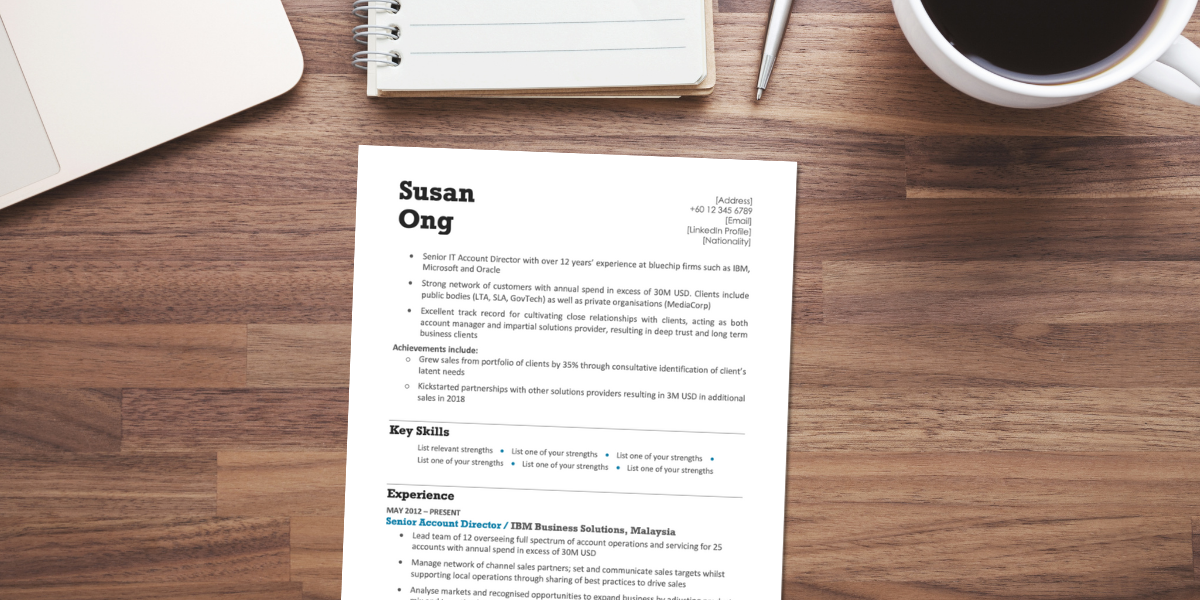Job Search Essentials
Resume & Cover Letter
Your Winning Resume Format Guide (2024) | Malaysia CV Format

You know it’s important to use the right resume format when crafting your CV.
But, what exactly is the “right” format?
From job boards to CV builders, the Internet is filled with plenty of suggestions. Unfortunately, most of this is noise. Don’t get me wrong — pretty resumes are great to look at! But elegant resumes and colourful CVs can only get you so far.
At ResumeWriter, we write CVs so our clients land jobs (We refund their purchase if they don’t!)
Having written CVs for the past 10 years, we’ve experimented with all kinds of resume formats. So, we’re pretty confident when we say that our resume format is one of the most effective formats you can use for your own resume.
Today, we’re opening our playbook to you and showing you the ultimate resume format that lands you jobs. Even better, we tell you what formats to avoid and why.
Curious to get in on our secret sauce? Read on to find out!
This guide will show you:
- What to include in your Resume Format?
- 3 Resume Formats to Avoid (and why!)
- ResumeWriter’s Winning 2024 Resume Format
- Additional Resume Writing Tips using our Format
A Winning Resume Format: Sections to Include
A resume is a formal document that sums up your entire career history and narrative. It’s important to follow a format that effectively communicates the necessary information to employers.
So, how do you format your resume?
This is one such format we encourage our clients to follow (find the full template below):
- Name and Professional Title
- Personal and Contact Information
- Executive Summary
- Technical Skills and/or Areas of Expertise
- Work Experiences (divided into 2 parts): Daily Work Duties and Key Achievements
- Education and Professional Qualifications
- Miscellaneous Information
- References
Yes, it’s this simple.
It also works for resumes across any industry. (Granted, a full-length CV includes sections such as Publications and Awards. An academic CV for postgraduate students will follow a different structure too. We’re working on guides for these!)
For most jobseekers, however, we’ve discovered that the format above works best.
Why?
- The candidate’s Executive Summary and Key Skills/Areas of Expertise are on the first page. This conveys the most essential information in the least amount of time. Even if a recruiter skims through a resume in 3 seconds, they will identify exactly what your key skills, talents and Achievements are — all at once!
- Allocating the Executive Summary its own section allows you to spin a career narrative. This makes you, the candidate, more memorable to recruiters. It helps you stand out from other candidates (with similar work experiences as you) vying for the same role.
- This resume format is easiest to read. Your career narrative is explicitly stated in the Executive Summary. Key Skills are neatly summed up in its own section. Daily workscopes and Achievements are separated. It’s clear and a joy to read. Recruiters appreciate this, and you will leave a great first impression!
Of course, each section in this resume format has its own nuances and pointers to watch out for. If you’re looking for a detailed, in-depth guide on how to write your CV (featuring a real client and step by step process), check out our Ultimate CV Guide!
We can also take the CV Writing (read: heavy lifting) off you! Just reach out to us, and our CV Consultants will work on your CV with you, using this exact resume format.
3 Resume Formats to Avoid
Ok, so our resume format works. It’s effective and great for recruiters, yada yada.
But why should you follow our format instead of others?
Because while job boards and resume builders craft gorgeous resumes, resume writing is our bread and butter. Clients depend on us for their future livelihoods. With stakes this high, we’re always on the lookout to find processes that work best!
We also advise against strategies that are proven to be ineffective.
Let us share with you 3 popular resume formats that do not work. We’ve learnt this the slow and painful way over 10 years of resume writing. Unfortunately, they are still advocated by some industry players as model templates to follow.
We strongly suggest you avoid making these same mistakes as us!
1. Skills-based Resume Format
As its name suggests, a skills-based resume format prioritises your skills over your Work Experience. Under this format, Job Titles for every work experience are replaced with Skills. Sometimes, the candidate’s Work Experience and company names aren’t even identified until the last page of the CV!
This is unfortunately poor resume writing.
Why?
It’s extremely difficult to read!
Recruiters like us read hundreds of resumes a day. An unclear resume is really frustrating to read, and will leave an unpleasant impression on us.
We aren’t reviewing resumes just to cross-check your skills with our own skills checklist. Instead, we review candidates holistically. Sure, skills are important. But we also look at prior work experiences, and how you’ve grown in your career. We look for a distinct career narrative, so candidates wouldn’t only fit in a role, but excel and succeed in it!
Some might say a skills-based resume is more helpful for someone with a gap in their CV. However, it’s important to be honest when you have a gap in your CV. As recruiters, we understand. But we also want to hear you explain these career gaps.
Be upfront and truthful with your work experience. Hiding any CV gaps in a hard-to-read CV isn’t going to help you or me.
2. Chronological Resume Format
A Chronological resume format puts your latest work experiences at the top, followed by past work experiences. In this format, the candidate dives right into their work experiences immediately after stating their Personal Information and Contact Details.
We advocate using such a structure when writing your work experiences, but not for the entire CV.
Why?
It’s very time-consuming to read! This format makes your CV very lengthy. It reads like an autobiography, outlining every nitty gritty detail in your career.
While we acknowledge you’ve done a lot in your career, it’s important to keep your resume concise and to the point. We’re looking for significant workscopes and Achievements that add value. We don’t need to know how you’ve attended meetings or drafted proposals.
This is why we recommend inserting an Executive Summary section at the start of your resume. It informs us all we need to know about your career, especially if we don’t have the time to read your full resume. This is also why we advocate separating your Workscopes and Key Achievements in your own resume. It makes your CV easier to read.
3. Narrative Resume Format
A narrative resume format is a resume that centers your career around a specific storyline. Think of narrative resume writing as writing a “one page novel”. You pick a specific career angle, outline your past work experiences as “challenges to overcome”, and elaborate how you managed to resolve them. You could either convey your story from a first or third person point of view, highlighting your key strengths.
Confused?
We’re equally baffled about this format.
Recounting your entire career history as a “one page novel” or narration fills your resume with walls of text. Reading your resume will be like reading an essay. We don’t have time for that!
It’s also likely that your strengths and key skills will be embedded within these paragraphs of texts. A lot of effort is required to extract them on our end. This makes our job exponentially more difficult!
However, one advantage of this format would be how memorable it is. Adopting such a unique, narrative-driven approach would help you stand out from jobseekers with similar work experiences. This explains why we advocate inserting a career narrative into your Executive Summary.
Now, you get the benefits of crafting an impactful Career Narrative, while keeping your resume concise and easy to read!
If you’ve noticed, we’ve taken the best of these 3 formats and combined them into our own resume format.
- Our resume format devotes an entire section to your Key Skills and Areas of Expertise
- Work Experiences are stated chronologically, but are clear and easy to read.
- Your Executive Summary includes a Career Narrative, helping you stand out from other jobseekers
So, how does our winning resume format look like?
ResumeWriter’s 2024 Resume Format
- Senior Sales Director with 10+ years of experience in B2C sales to clients in industries such as FMCG, F&B, hospitality, and automotive.
- <More career overview or key workscope lines here>
- Discover how to write an Executive Summary here
- Lead team of 10 executives to drive all aspects of sales and marketing for leading FMCG brand.
- Prepare strategic business plan, monthly reports, setting of revenue targets, and business forecasts.
- <More work descriptions here>
- Consistently exceeded sales target by 120% month on month.
- Learn how to Write Accomplishments on your Resume here.
- <Insert work descriptions here>
- <Insert achievements here>
- <Insert work descriptions here>
- <Insert achievements here>
- [Degree], [Course], [Institution] | YYYY-YYYY
- [Degree], [Course], [Institution] | YYYY-YYYY
- Technical Skills: MS Office Suite
- Languages: English, Chinese
- Availability: 1 months’ notice
References available upon request [There’s no need to list your references; if HR is interested in you they will ask you for them.]
What do you think of our resume format?
After 10 years of writing resumes, we’ve learnt that this format works best.
We use it to write all our clients’ CVs, and in our Ultimate CV Writing guide. And the best part?
It clearly brings results to our clients.
Want to try using our winning resume format?
We’ve crafted 11 downloadable modern resume template designs. Start by learning the basics of great CV writing, then use one of our resume templates as a base to craft your very own job-winning CV.
Once you’re done with your CV, send it to us for free CV feedback! Our experts will share feedback on your CV fares, and suggest areas of improvement.
Before you go, here are a few additional resume writing tips. Check out our Ultimate CV Writing Guide for more!
Additional Resume Writing Tips for 2024
- Keep your resume as short and as concise as possible. Leave out work descriptions that are already implied or obvious. As much as possible, your resume would not exceed 2 pages.
- Focus on your current and latest 2-3 work experiences. Earlier career history such as internships and part-time jobs should not take a lot of space on your resume.
- Include important and relevant keywords throughout your resume. Most companies use resume scanning software to filter candidates’ resumes based from keywords and terminologies associated to the position.
- Make sure to showcase significant achievements such as successful projects managed, key accounts handled, as well as quantifiable metrics that can support your strengths.
- Attach a cover letter to your resume when applying for jobs to personalise your application and provide a “teaser” to hiring managers as to why you are best candidate for the position.

